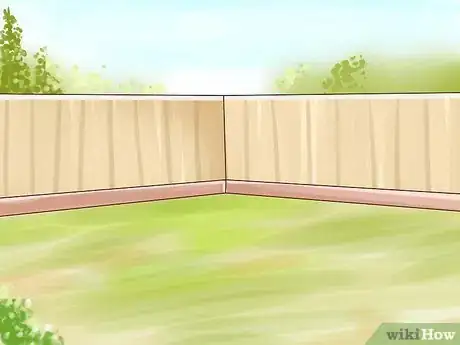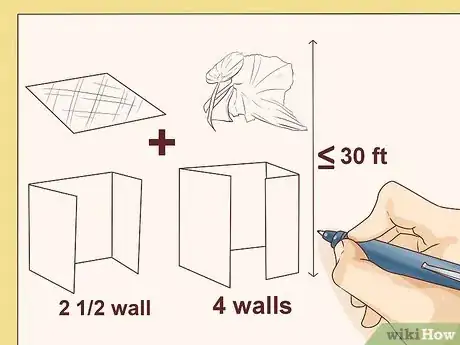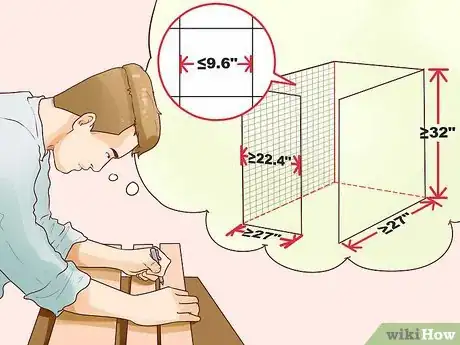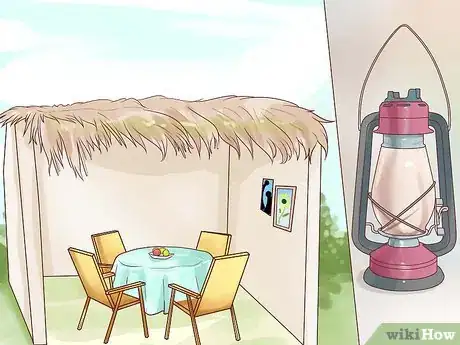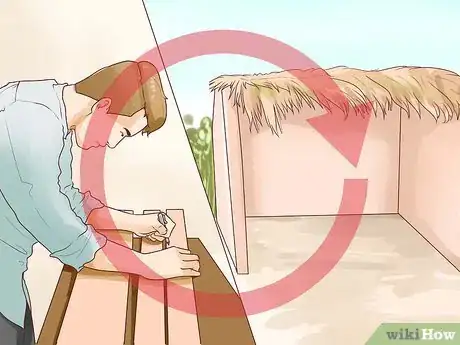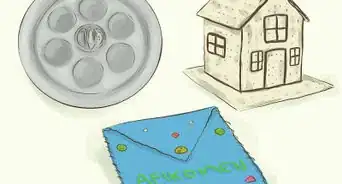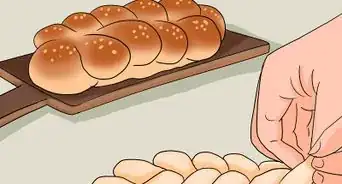This article was co-authored by wikiHow Staff. Our trained team of editors and researchers validate articles for accuracy and comprehensiveness. wikiHow's Content Management Team carefully monitors the work from our editorial staff to ensure that each article is backed by trusted research and meets our high quality standards.
There are 12 references cited in this article, which can be found at the bottom of the page.
This article has been viewed 44,362 times.
Learn more...
A sukkah is a simple hut used during the Jewish holiday of Sukkot. It is a symbolic dwelling that commemorates the time that the Israelites spent in the wilderness after they were freed from slavery in Egypt. With a few simple materials and a little time, you can build your own sukkah to use during this celebration.
Steps
Designing Your Sukkah
-
1Start building at the right time. Most experts suggest that you should start building your sukkah right at the end of Yom Kippur.[1] If you cannot start building at the end of the day, then start early the next morning. Ideally, the structure should be finished on the day after Yom Kippur, but don’t finish until the structure is built safely.
-
2Choose a spot outdoors.[2] Building your sukkah near your home is ideal for convenience. One important condition, however, is that nothing must be blocking the top of your sukkah from the open sky. This means that no tree limbs, roofs, etc. should hang over it.[3]
- The sukkah must be exposed to open sky because it must be able to provide functional shade to represent the protection similar huts gave Jews in the wilderness.[4] Functional shade means that the sukkah's roof will block most sunlight, but let some shine through to make a person aware of the shade.
- If you do not have a yard, you can build a sukkah on a balcony (as long as it is not covered by another balcony).[5]
Advertisement -
3Plan your sukkah. A sukkah should have a minimum of at least two walls plus part of a third wall (at least 3.2 inches wide).[6] However, it is preferable for the sukkah to have four full walls.[7] There does not need to be an actual door, but there must at least be a doorway so that you can enter the structure. Your sukkah must also have a roof. The structure should be at least 32 inches high, but not taller than 30 feet (about 10 meters or 20 amount).[8]
- These size specifications are determined by traditional Jewish law to ensure that the sukkah is large enough to serve the basic functions of a dwelling: eating and sleeping.[9]
- You can make a sukkah that is larger than the minimum if you want to have room for more people in it, or space for other activities.
-
4Gather materials. You can use any materials to build the walls of the sukkah, but you must use special raw plant-based material (sechach) to build the roof. It helps to gather all of your materials before beginning to build your sukkah. However, you must build it in the right order. The roof material should not be laid until you have completed the walls.[10]
Building and Using Your Sukkah
-
1Build the walls. Keep in mind that the walls of your sukkah should be at least 32 inches high, and larger than 22.4 inches in length and breadth. A floor space of at least 27 by 27 inches (70cm x 70cm or seven tefachim by seven tefachim) is recommended, to provide enough room for a person to sit down.[11] [12] There can be gaps in the material making up the sukkah’s walls. However, these gaps should not be wider than 9.6 inches. You can make the walls of your sukkah out of any material that is suitable enough not to be blown around in the wind.[13] [14] For instance, you could:
-
2Build the roof covering. To be kosher, the roof of a sukkah must be made out of sechach, or raw plant material not used for any other purpose, as the Book of Deuteronomy (16:14) specifies.[17] [18] [19] You can lay long strips of material over the walls of your sukkah, then build up layers of sechach until the roof is thick enough to block out most sunlight, but let some shine through.[20] [21] Do not tie down or support the roof with any non-sechach materials, especially metal. Possible materials for building the roof can include:
- Bamboo
- Evergreen branches
- Reeds
- Corn stalks
- Straw
- Special schechach mats (these must be designed and intended specifically for serving as the roof of a sukkah)[22]
-
3Embellish your sukkah. You can add lighting (such as a portable lamp and an extension cord), chairs and/or a table, posters, or fresh fruit to decorate your sukkah.[23] [24] This makes the dwelling more festive and personal. However, Chabad custom encourages the act of building and using the sukkah in remembrance to be thought of as real beauty.
-
4Rebuild your sukkah each year. You can reuse the base of your sukkah each year. However, you must replace the sechach materials of the roof.[25] Store the structure safely to protect it from wind and water.
-
5Use the sukkah. Once your sukkah is built, you should use it for seven days, according to Leviticus 23:42.[26] This period serves as a remembrance of the time that Jews spent in the wilderness. The basic function of a sukkah is to provide shade, and room for sleeping and eating.
- According to tradition, you should eat at least your meals (if not all snacks) in the sukkah during Sukkot.[27]
- You can sleep in the sukkah if you want, but you do not have to if it is uncomfortable (too hot, too cold, wet, etc.) or inconvenient.[28]
- The sukkah is a symbolic dwelling, so you can also use it for other activities you would normally do in your home, such as working, talking with friends and family, reading a book, etc.[29]
Community Q&A
-
QuestionIs there an equivalent to this process that would be easier for kids?
 Community AnswerBuy a tent and decorate the inside and outside with paper leaves, fruit, vegetable, etc, which the kids can make themselves.
Community AnswerBuy a tent and decorate the inside and outside with paper leaves, fruit, vegetable, etc, which the kids can make themselves.
References
- ↑ http://www.aish.com/h/su/dits/48969031.html
- ↑ https://www.chabad.org/library/article_cdo/aid/420823/jewish/How-to-Build-a-Sukkah.htm
- ↑ http://www.beingjewish.com/yomtov/sukkos/build.html
- ↑ https://www.chabad.org/library/article_cdo/aid/2720149/jewish/Sukkology-101.htm
- ↑ http://www.aish.com/h/su/dits/48966756.html
- ↑ http://www.beingjewish.com/yomtov/sukkos/build.html
- ↑ http://www.aish.com/h/su/dits/48969031.html
- ↑ http://www.aish.com/h/su/dits/48969031.html
- ↑ https://www.chabad.org/library/article_cdo/aid/2720149/jewish/Sukkology-101.htm
- ↑ http://www.aish.com/h/su/dits/48966756.html
- ↑ http://www.aish.com/h/su/dits/48966756.html
- ↑ http://www.aish.com/h/su/dits/48969031.html
- ↑ http://www.beingjewish.com/yomtov/sukkos/build.html
- ↑ https://www.chabad.org/library/article_cdo/aid/420823/jewish/How-to-Build-a-Sukkah.htm
- ↑ http://kosheronabudget.com/building-decorating-your-sukkah-on-a-budget/
- ↑ http://www.myjewishlearning.com/article/how-to-build-a-sukkah/
- ↑ https://www.chabad.org/library/article_cdo/aid/2720149/jewish/Sukkology-101.htm
- ↑ http://www.myjewishlearning.com/article/how-to-build-a-sukkah/
- ↑ https://www.chabad.org/library/article_cdo/aid/420823/jewish/How-to-Build-a-Sukkah.htm
- ↑ http://www.aish.com/h/su/dits/48969031.html
- ↑ http://www.beingjewish.com/yomtov/sukkos/build.html
- ↑ http://www.beingjewish.com/yomtov/sukkos/build.html
- ↑ http://www.aish.com/h/su/dits/48966756.html
- ↑ https://www.chabad.org/library/article_cdo/aid/420823/jewish/How-to-Build-a-Sukkah.htm
- ↑ https://www.chabad.org/library/article_cdo/aid/420823/jewish/How-to-Build-a-Sukkah.htm
- ↑ https://www.chabad.org/library/bible_cdo/aid/9924/jewish/Chapter-23.htm#v=42
- ↑ https://www.chabad.org/library/article_cdo/aid/999940/jewish/The-Sukkah-The-Holiday-Hut.htm
- ↑ http://www.chabad.org/holidays/JewishNewYear/template_cdo/aid/749894/jewish/Do-I-have-to-sleep-in-the-sukkah.htm
- ↑ https://www.chabad.org/library/article_cdo/aid/2720149/jewish/Sukkology-101.htm

